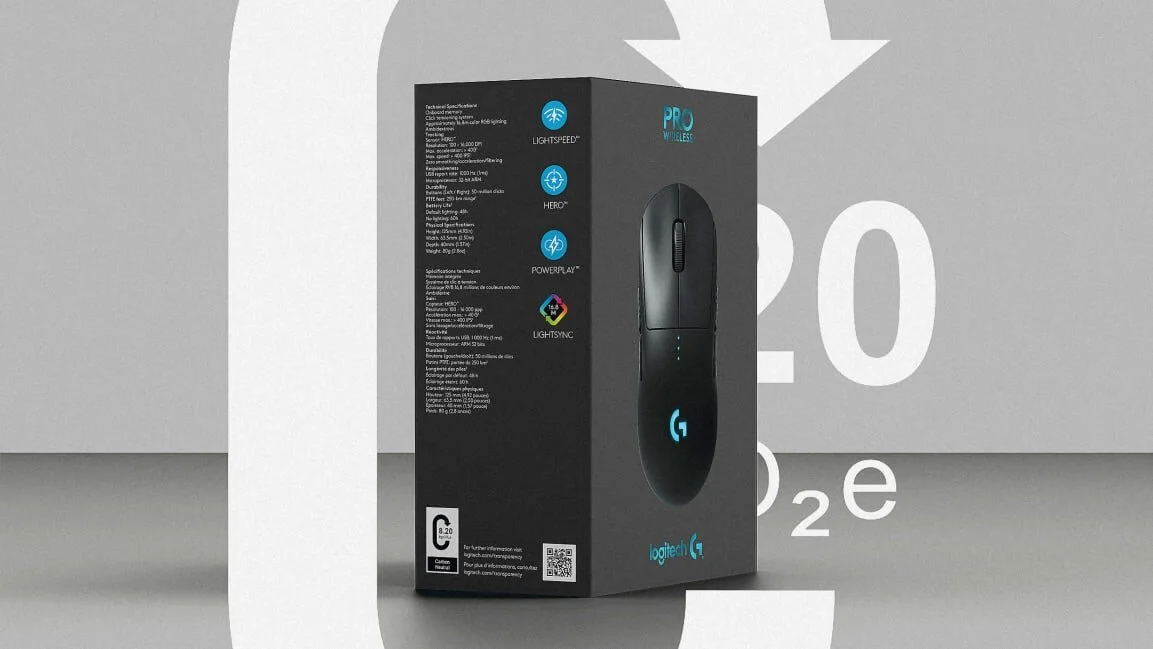4 MINUTE READ
The best iPhone you can buy is no iPhone at all. That’s because the technology comes with a hidden cost: the environmental footprint. Every product design comes with a long tail of energy and resource costs you never see.That is, until now. Logitech, one of the biggest peripheral manufacturers in the world, is the first tech company to begin labeling its products with their total carbon footprint. Starting with its gaming mice, keyboards, and headsets, and then on all products by 2025, Logitech will be printing the kilograms of carbon that went into making that product on the product itself. Logitech has made considerable efforts on a path to go carbon neutral, and now, it wants its environmental impact to be as digestable as a set of Nutrition Facts—a challenge that will ultimately require other companies to get involved, too.
“We believe the best way to get companies to drop their carbon consumption is to make it a competitive marketplace around transparency, where consumers can see how much carbon is going into the things they buy,” says Bracken Darrell, CEO of Logitech. “There’s no hidden agenda here. It’s that simple. We think it will be super competitive over time.”
No law or mandate states that Logitech needs to disclose its carbon footprint. But like Apple and Microsoft, Logitech has agreed to abide by the goals of the Paris Agreement. The difference here is that, while most big tech companies do publish reports on sustainability, none have gone so far as to disclose those numbers as a feature of a product or a differentiator in the market.
To build its carbon label, Logitech has been on an eight-year audit of its own environmental practices, for which it enlisted the specialists Natural Capital Partners, IFU, and DERKA. Darrell insists that lowering its carbon footprint was already driving design at Logitech, leading them to begin using recycled plastic in 25% of its mice starting last year, despite that improvement coming at a higher cost. They plan to move to 100% recycled plastic for all products in the future. “You can’t be a design company without being a design-for-the-environment company,” he says. To reduce its carbon footprint, Logitech also uses renewable energy in its factories.
As for the label itself, the company designed it as a big letter C, pointing downwards (as in, let’s emit less carbon over time). Inside the C, you see the kilograms of carbon put out by the product. Then it’s labeled “carbon neutral” or labeled that it’s not (currently Logitech’s entire gaming line is carbon neutral). “If you bought a bag of chips and looked at the nutritional label, you see 130 calories, and you know what it means,” says Prakash Arunkundrum, head of sustainability and operations at Logitech. “We want to be at the same place with carbon.”
“We tried to keep it as simple as possible. So you know more is worse and lower is better,” adds Darrell. “If I’m trying to decide between two $99 mice . . . I can see which [carbon footprint] is worse.”
It’s a simple design; it’s also presented without much context. Even Nutrition Facts break down fats and carbohydrates into not just grams, but a percentage of an overall daily value. These values are debated to this day, but there’s a baseline for you to consider. Logitech’s label makes sense compared to another, similar product, but otherwise, it’s just a number. And it only works comparing Logitech products to other Logitech products, given that no other companies have adopted it yet. When I broach this criticism, the team at Logitech agrees about the shortcoming.
“It doesn’t put it into context of how much carbon is too much. We do think that’s a gap. If we tried to put it on the package, it would be War and Peace on the product. No one will read it,” says Darrell. “We don’t have the answer to that yet. We’re happy to have a discussion.”
Another potential shortcoming is that Logitech isn’t disclosing the consumption of rare earth minerals on its product label either. These are materials you’ve never heard of, like neodymium, yttrium, and terbium, some of which are scarce, and their mining can be devastating to the environment. Logitech is tracking and disclosing the carbon footprint of such mining in its products as part of its carbon score, but that’s only one metric of the total impact of such mining.
Arunkundrum agrees that carbon is just one measure of environmental impact, but he believes that it’s the most important. “[Carbon] is the most well-defined factor that attributes to climate change,” says Arunkundrum. “We’ve gotten rid of a lot of metallics in our products over the years . . . but if you project out into the future, the single biggest thing we’re trying to influence is climate change, and it’s directly measurable and quantifiable with the carbon methodology.”
Indeed, Logitech is taking an aggressive step in advertising its carbon footprint, but the company is not convinced it has the perfect approach yet. Darrell has offered to share its design and methodology freely with any other company that would like to adopt it, or, he says Logitech is open to adopting another design altogether.
“It doesn’t need to be our approach on the labeling; we’re happy to adopt someone else’s,” says Darrell. “We just want to drive this forward, and we want the consumer pressure on all industries to look at carbon [footprint] as a feature of products.”
